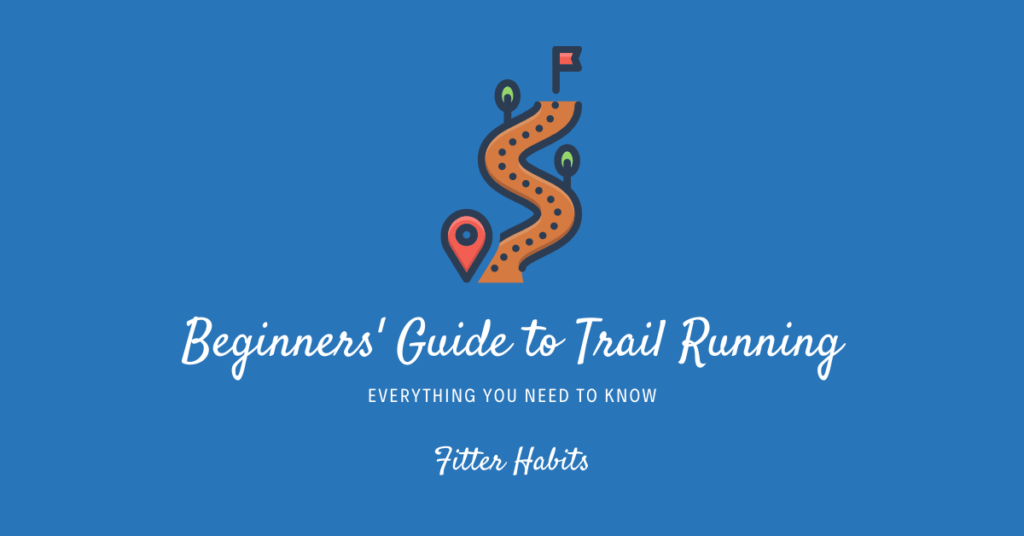Our beginners’ guide to trail running will teach you everything you need to know to hit the trail.
If you’re a dedicated runner, you may have heard about trail running. Devotees enjoy the exercise as well as the chance to explore new routes and scenery. Here are some things you should know before you strike out on the trail.
Contents
What is Trail Running?

Trail running refers to running — usually long distance — on natural terrain rather than on a track or road. This might be on a mountain trail, dirt road, or through the woods.
Trail running offers some unique opportunities and challenges. Because of the uneven terrain, you’ll probably find yourself exercising muscles you’re not used to working. It’s a great chance to get fresh air and enjoy scenic views while improving your running technique.
Trail running combines cardio and climbing health benefits, making it an excellent choice for anyone who wants to improve their endurance and cardiovascular health.
What Are The Benefits of Trail Running?
The type of exercise trail running offers is unique. Naturally, it is great for elevating your heart rate, but the strain on your legs from running on rough terrain with elevation gain also helps develop your glutes, quads, and core.
The challenge of navigating around roots, stones, plants, and other barriers improves your balance and agility. While you’re doing this, you’ll be engaging your core. Connective tissues are engaged as well.
Meanwhile, running on a soft surface like dirt is gentle on your joints, sparing you some of the joint damage that you risk while road running.
Trail Running vs Road Runs
This all-in-one workout is more effective than running on a hard surface. You’ll burn 10 percent more calories, on average, running on a trail. This is yet another reason that trail running is such a popular activity for dedicated runners.
Road running is usually on flat, hard surfaces like tarmac. Although these surfaces are good for speed workouts, they’re harder on the body. Similarly, road runners usually train in a suburb or urban area and have traffic to contend with. Trail runners get to spend more time in nature and don’t usually have to worry about vehicles.
How Do You Get Started?
You can’t just start trail running — you need to prepare first. Trail running is out in nature, so you’ll need to gather some gear and take proper safety precautions. These trails can be unpredictable, and there is always the chance that you’ll run into an animal, a steep incline, or sudden elevation changes.
You should also know how to do some trail running techniques. Most of these are probably somewhat intuitive for experienced runners. They involve adjusting your stride based on the terrain and incline, using your arms, and other tips for conserving energy.
Lastly, do some research, especially before trail racing. Before you strike out into nature, learn about the trails in your area to determine which one is best suited for you.
What Gear Do You Need?

For trail running, you’ll need special trail running shoes. These are made with thick soles that maximize grip and protection. They help you stay safe on any kind of trail, especially ones with shifting rocks or steep hills.
Gear for Longer Trips
If you’re planning on hitting the trail for just a short while, you probably don’t need much special gear. However, if you’re going to an isolated site or planning on running for several hours, you should prepare accordingly.
Bring a hydration pack, hydration vest, or multiple water bottles. Pack some easy-to-carry snacks, particularly protein bars or other energy-fueling food. You may also want to carry a small first aid kit with bandages, antiseptic ointment, and blister protection.
Sunblock is another necessity. Depending on where you’re planning to run and how far away you’ll be from help, it may also be a good idea to pack a cell phone, compass, GPS watch, or headlamp.
How to Choose a Trail
Before you get started, take the time to do some research about your local trails; every trail is unique, which is one of the attractions of trail running. Check out your local guides, Google Maps, or running clubs. They will help point you in the direction of great courses for your needs and goals.
You can also use Trail Run Project to pinpoint the best trails in your area. Other apps like Map My Run and Strava offer similar features for finding your first nearby trail.
There are other useful resources including social media groups and plain old maps. Looking at a map can help you identify local green areas that might have good places to run. National and state parks often have excellent trails.
When considering your options, base your decision on your experience and fitness levels. You can also think of what kind of terrain you want to try and how far the trails are from assistance if you need it.
What Else Do You Need to Know?
Trail running can be surprisingly tiring at first. Every trail has its own terrain and incline, which means that you’ll be working out muscles you’re not used to working out.
Go easy at first and don’t get discouraged if you need to take more breaks or go at a slower pace than usual. Embarking on a trail run means dealing with more hills and challenging surfaces. New trail runners take some time to develop competence, as a result.
Safety Tips for New Trail Runners

Trail running can also be unpredictable, so take safety precautions. Ensure you have some basic medical supplies and a way to call for help if you get injured.
One of the basic trail running tips when you’re on the trail is to look ahead. It’s tempting to turn around and admire the scenery, only to fall down a steep hill or roll an ankle on a rock.
Bring a GPS watch so you can find your way back to your vehicle. Most newer Garmin watches, like the 245, have a “Back to Start” feature and in-built compass. Your phone can also suffice, assuming it’s charged and has reception.
Let someone know where you went when they can expect you back. The Beacon feature on the running app Strava is ideal for trail runners who want to share their location with others.
Beginners’ Guide to Trail Running: The Final Word
Trail running is an excellent workout. It exercises not only your cardiovascular system but also your connective tissue, glutes, calves, and core. Trail runners also love the chance to improve their endurance — without doing endless and repetitive exercises on a track.
Remember to take care while running on a trail whether it’s your first time or your first ultramarathon. You never know what you will find off-road. Trail running does take some preparation. But if you know what you’re doing, trail running can be a healthy and rewarding activity — not just for your body but for your mind as well.



